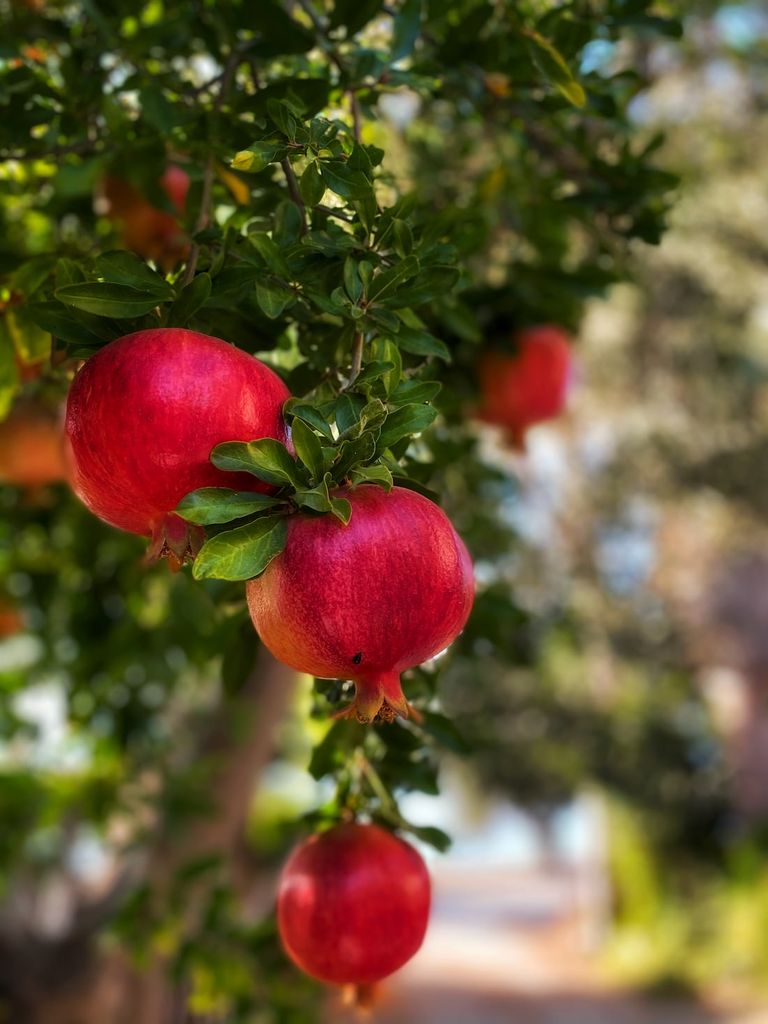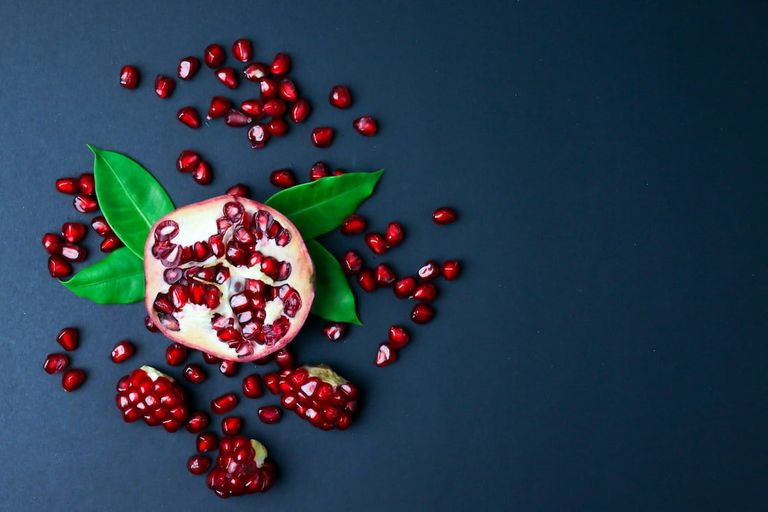Assalamu Alaikum
everyone,
Hello..!!
My Dear Blurt Friends,
I am @darkclown.
Assalamu Alaikum I hope you all are fine by the grace of Allah I am also fine. Today I will share with you information about Pomegranate and its qualities.

Source
The pomegranate (Punica granatum) is a fruit-bearing deciduous shrub in the family Lythraceae, subfamily Punicoideae, that grows between 5 and 10 m (16 and 33 ft) tall.
Scientific classification:
Kingdom:
Plantae
Clade:
Tracheophytes
Clade:
Angiosperms
Clade:
Eudicots
Clade:
Rosids
Order:
Myrtales
Family:
Lythraceae
Genus:
Punica
Species:
P. granatum.
The pomegranate was originally described throughout the Mediterranean region. It was introduced into Spanish America in the late 16th century and into California by Spanish settlers in 1769.[4]
The fruit is typically in season in the Northern Hemisphere from October to February,[5][failed verification] and in the Southern Hemisphere from March to May. As intact sarcotestas or juice, pomegranates are used in baking, cooking, juice blends, meal garnishes, smoothies, and alcoholic beverages, such as cocktails and wine.
Pomegranates are widely cultivated throughout the Middle East and Caucasus region, north and tropical Africa, Iran, Armenia, the Indian subcontinent, Central Asia, the drier parts of Southeast Asia, and the Mediterranean Basin.
DETAILS:

Source
This is a kind of result. Its English name is Pomegranate. In Hindustani, Persian and Pashto it is called Annar (انار). It is called Hinar in Kurdish and Nar in Azerbaijani. It is called Darim in Sanskrit and Nepali. Currants are shrubs, up to 5-8 meters tall. Ripe fruits are red in color. Inside the fruit shell there are red grains like crystals. They are eaten.
EXPANSION :
It is native to Iran and Iraq. It has been cultivated in the Caucasus region since ancient times. From there it spread to the Indian subcontinent. The Spanish took currants to Latin America and California in 1769. As a result, it is currently being cultivated in California and Arizona. In the Northern Hemisphere it grows from September to February. It grows from March to May in the Southern Hemisphere.
Currently it is Turkey, Iran, Syria, Spain, Azerbaijan, Armenia, Afghanistan, India, Pakistan, Bangladesh, Iraq, Lebanon, Egypt, China, Burma, Saudi Arabia, Israel, Jordan, Philippines, Arid region of Southeast Asia, Mediterranean region. , is widely cultivated in southern Europe and tropical Africa.
MEDICINAL PROPERTIES :
Pomegranate fruit is used as food in Ayurvedic and Unani medicine. Pomegranate contains butylic acid, arselic acid and some alkaline products such as - cidoperetirin, pepretirin, isoperetirin, methylperetirin etc., so it is used to relieve various diseases. According to Kaviraj, pomegranate is the best beneficial fruit for the heart. This fruit is considered beneficial for constipation patients. Medicines for dysentery and diarrhea are prepared from the roots, bark and fruit peel of the plant. It is a tridosh reliever, sperm enhancer, burning-fever thirst quencher, intellectual and energizing, anesthetizing and satiating. Pomegranate flowers are hemostatic.
Pomegranate flowers are very effective in stopping bleeding. If a part of the body is torn, bruised or cut in a sudden accident and bleeds, the bleeding will stop if a pomegranate flower is crushed and pressed on the wound. Leaves also work well if flowers are not available.
Pomegranate flower juice is the main remedy for sudden nosebleeds. Nosebleeds are a common disease. This happens to many people. Many people get nosebleeds for no reason. It can also be seen in children. It happens suddenly. If the nose bleeds or bleeds without injury, polyps or any other reason, crushing the pomegranate flower and inhaling the juice into the nose will stop the bleeding.
Pomegranate peel to cure dysentery. Those suffering from dysentery, consuming pomegranate peel after boiling can get good results in curing dysentery. Both raw and dry pomegranate peels are effective in treating dysentery. So it is better to dry the pomegranate and keep it at home instead of throwing away the peel.
Pomegranate bark powder and spread on it works well to cure buggies or stings in any part of the body. Pomegranate flowers are useful in curing women's pelvic diseases. Prolapse is a complex female disease. There are two types of pradar. White and bloody. In both types of pradar, 4/5 pomegranate flowers mixed with honey and consumed for a few days cures the disease.
Pomegranate leaves are useful in treating miscarriage. Many women miscarry within two to three months of conception. Some women experience this more than once. Pomegranate leaves mixed with honey and curd and consumed together can eliminate the risk of miscarriage.
Pomegranate root is an antiseptic. Creamy problem is our national problem. Everyone from children to old people suffer from various complications due to creams. If the bark is taken from the roots or roots of the pomegranate tree and mixed with lime water and consumed, creminash is easily produced. 1-3 grams should be prescribed depending on the age.
Pomegranate bark to cure stomach ailments in children. Children suffer from various types of colic. For children who suffer from various types of stomach pains including enlarged stomach, taking the bark from the roots of the pomegranate tree and mixing it with honey gives good results.
According to many people it is also said that eating pomegranate increases blood in the body.
Eating pomegranate keeps diabetes under control. Natural Insulin Pomegranate is beneficial for diabetes.
Basically, the pomegranate tree – from the fruit, the peel, the leaves to the roots – is not edible. Helping people first.
ETYMOLOGY:
The name pomegranate derives from medieval Latin pōmum "apple" and grānātum "seeded".[6] Possibly stemming from the old French word for the fruit, pomme-grenade, the pomegranate was known in early English as "apple of Grenada"—a term which today survives only in heraldic blazons. This is a folk etymology, confusing the Latin granatus with the name of the Spanish city of Granada, which derives from Arabic.
Garnet derives from Old French grenat by metathesis, from Medieval Latin granatum as used in a different meaning "of a dark red color". This derivation may have originated from pomum granatum, describing the color of pomegranate pulp, or from granum, referring to "red dye, cochineal".
The modern French term for pomegranate, grenade, has given its name to the military grenade.
DESCRIPTION:
A shrub or small tree growing 5 to 10 m (16 to 33 ft) high, the pomegranate has multiple spiny branches and is long-lived, with some specimens in France surviving for 200 years. P. granatum leaves are opposite or subopposite, glossy, narrow oblong, entire, 3–7 cm (1+1⁄4–2+3⁄4 in) long and 2 cm (3⁄4 in) broad. The flowers are bright red and 3 cm (1+1⁄4 in) in diameter, with three to seven petals. Some fruitless varieties are grown for the flowers alone.
FRUIT, SARCOTESTA AND SEEDS:
Red-purple in color, the pomegranate fruit husk has two parts: an outer, hard pericarp, and an inner, spongy mesocarp (white "albedo"), which comprises the fruit inner wall where seeds attach. Membranes of the mesocarp are organized as nonsymmetric chambers that contain seeds inside sarcotestas, which are embedded without attachment to the mesocarp. Containing juice, the sarcotesta is formed as a thin membrane derived from the epidermal cells of the seeds. The number of seeds in a pomegranate can vary from 200 to about 1,400.
Botanically, the edible fruit is a berry with seeds and pulp produced from the ovary of a single flower. The fruit is intermediate in size between a lemon and a grapefruit, 5–12 cm (2–4+1⁄2 in) in diameter with a rounded shape and thick, reddish husk.
In mature fruits, the juice obtained by compressing the seeds yields a sour flavor due to low pH (4.4) and high contents of polyphenols, which may cause a red indelible stain on fabrics. Primarily, the pigmentation of pomegranate juice results from the presence of anthocyanins and ellagitannins.
This is link of information:
Source
KNOW 10 TIMES OF POMEGRANATE QUALITY:

Source
There are many benefits of eating pomegranate. However, many people do not want to eat pomegranate because it is a bit expensive. However, regular consumption of pomegranate benefits the body. Some of the benefits are highlighted in this article. In a report, Bright Side said this.
Nutritional value Pomegranate is rich in nutrients. Just one cup of pomegranate seeds contains 30 percent of your daily requirement of vitamin C, 36 percent of vitamin K, 16 percent of vitamin B9 and 12 percent of potassium.
Blood Pressure Pomegranate helps lower blood pressure. If you suffer from high blood pressure then regular consumption of pomegranate will bring your blood pressure back to normal in just two weeks.
Arthritis and joint pain relief Pomegranate benefits in arthritis. It also helps relieve joint pain.
Reduces the risk of heart disease Pomegranate reduces the risk of cholesterol in the body. It increases blood circulation and reduces the risk of heart disease.
Improves memory Pomegranate helps in improving memory. And because of this it is also beneficial for patients like Alzheimer's.
Increase Hemoglobin Pomegranate contains many nutrients, which increase the level of hemoglobin in the body. It plays a role in eliminating anemia and various blood problems.
Natural Insulin Pomegranate is beneficial for diabetes. Many say it as an alternative to insulin. It is sweet but usually not a problem for diabetics.
Anti-cancer Pomegranate has several benefits, including cancer prevention. Research has proven its role in preventing breast cancer in particular.
Antibacterial Pomegranate builds immunity against bacterial infections in the body. Besides, it plays a role against fungal infection.
Increasing the performance of physical exercises Many people do physical exercises to stay healthy or for better performance. Experts say that eating pomegranate along with exercise can help boost performance.
Source
Thanks for reading this post ...